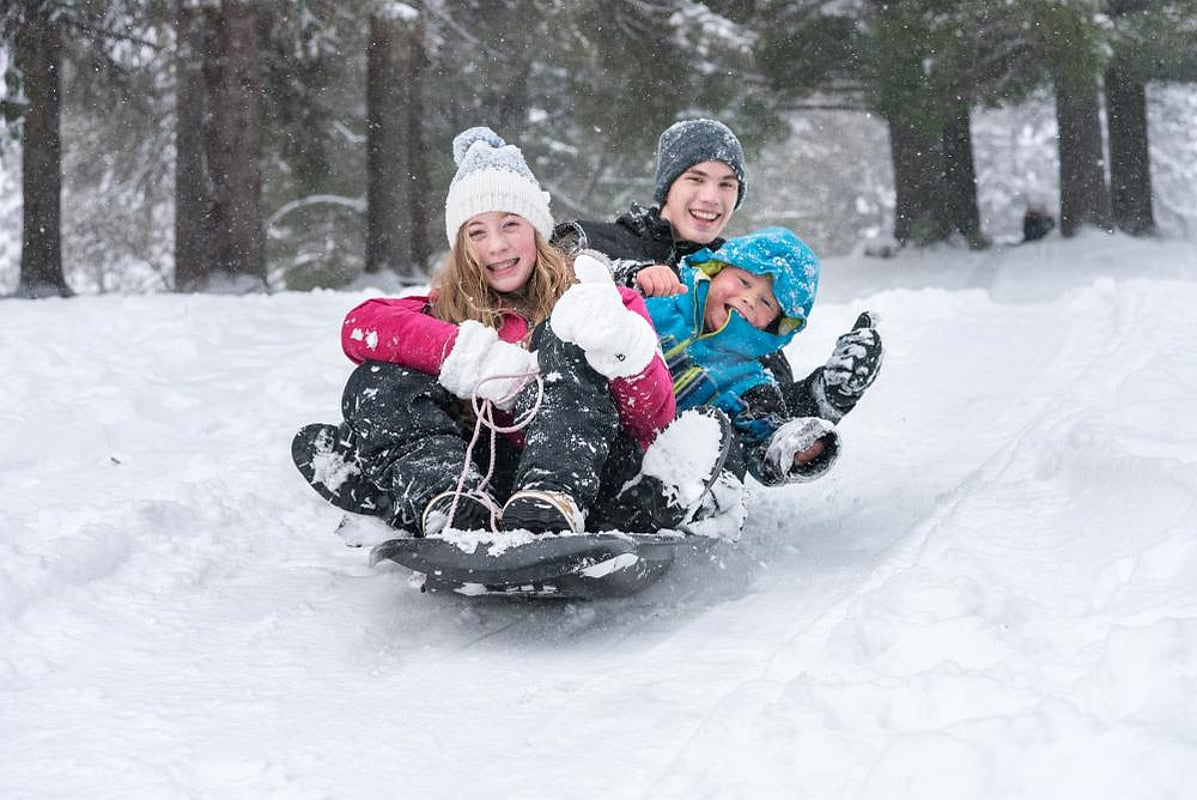Sledding Safety

Taking the spills out of sledding would be like taking away the snow. Little kids may be perfectly happy to glide down a gentle slope and ease to a stop at the bottom -- but such a run may seem tame to those with a few winters under their belts. Many older kids love the feeling of flying down a hill with no guarantee of a clean landing. Left to their own devices, they might straddle a piece of cardboard and ride over a cliff. This is why they aren't left to their own devices.
Parents can't crash-proof their kids, but they can draw the line between good winter fun and reckless abandon. It's a line that far too many children cross. According to the National Safety Council, sleds and toboggans send more than 34,000 people to the emergency room each year. Throw in inner tubes, and the number can shoot well past 160,000, according to the American Academy of Orthopaedic Surgeons. While sledders come in all sizes, 5- to 9-year-olds are the most likely to suffer injuries. At this age, kids have a well-developed sense of adventure but little sense of self-preservation.
What kinds of injuries are caused by sledding?
The injuries that happen during sledding depend on the sled, the slope, and the rider. Kids under 5 often ride headfirst on runner sleds, a technique that makes them vulnerable to head-on collisions with trees or telephone poles. Not surprisingly, head, neck, and facial injuries are especially common among young riders. They can also hurt themselves by catching their hands or fingers under the runners.
Older kids like to sit on sleds, which is actually a relatively safe approach. But if they hit a bump at 20 mph, they can easily fly into the air and land hard on their bottoms. For this reason, they are vulnerable to spinal injuries. They can also hurt their arms and legs if they try to break a fall.
How can sledding injuries be avoided?
Here are some tips for keeping your kids safe during the sledding season:
- Make sure children know that sledding can be dangerous. They'll be more likely to listen to you if they know their fun could be cut short by bumps, bruises, or even broken bones.
- Encourage riders to go feet first down the slope by sitting face forward on the sled. This approach will greatly reduce the risk of head injuries.
- Buy your child a classic steerable runner sled. Not only do these sleds have a certain retro chic, they're much easier to control and much safer than toboggans, inner tubes, or plastic saucers.
- Check the terrain. Many young sledders think that trees, rocks, bare patches, creeks, and other obstacles are just part of sledding. They don't realize how quickly one of these hazards could put an end to the fun. Make sure the slope is gentle, clear from top to bottom, and doesn't end near a road or freeway.
- Keep your child away from makeshift snow ramps. While it may be tempting to go sailing through the air like Evel Knievel, ramps are hazardous and can even be deadly. A 13-year-old Wisconsin girl died in 2002 after her sled hit a snow ramp and went out of control, sending her tumbling through the air until she landed on her head and back.
- Bundle kids up. Younger children are more susceptible than adults to hypothermia, a potentially life-threatening situation where the body temperature falls well below normal. Be sure to check youngsters often, and bring them in right away if they get wet -- water and wind can reduce body temperature quickly. Older kids should dress in warm layers. In addition to protecting your child from the elements, proper winter clothing from head to toe can help cushion falls.
- Consider buying your child a helmet, especially if she's under 12. Helmets have become standard equipment for sports such as skateboarding and downhill skiing, and they wont seem out of place on the sledding hill.
- Tell your kids to come inside for regular water breaks. Sweating under heavy winter clothing and breathing hard from exertion can cause dehydration.
- Don't forget the sunscreen. Even though there may not be much skin peeking out from under those heavy coats and caps, sunlight reflecting off the snow can burn it in a hurry.
- Most of all, watch your young ones to make sure they're following the rules. Better yet, get your own sled and race them to the bottom. Kids may be fearless, but gravity is on your side.
References
American Academy of Orthopaedic Surgeons. Winter Sports Injury Prevention. http://orthoinfo.aaos.org/topic.cfm?topic=A00062
American Academy of Orthopaedic Surgeons. Sledding Injury Prevention. http://orthoinfo.aaos.org/topic.cfm?topic=A00306
BJC Healthcare. The ups and downs of sledding safety. No date given.
National Safety Council. Tips for safer sledding and tobogganing. http://www.nsc.org/news_resources/Resources/Docume...
American Association of Orthopaedic Surgeons. Sledding Safety.. http://www.aaos.org/about/papers/position/1137.asp
Tosa incident kills 1; girl, 13, succumbs to weekend injuries. By Jesse Garza, Lauria Lynch, and Lawrence Sussman. Milwaukee Journal Sentinel. January 22, 2002.
Photo credit: Shutterstock
Related Posts
Reguladores europeos investigan el riesgo de ideación suicida con unos populares fármacos para perder peso
MARTES, 11 de julio de 2023 (HealthDay News) -- La Agencia Europea de...
Extirparán una lesión encontrada en la parte superior del ojo derecho de Jill Biden
MIÉRCOLES, 11 de enero de 2023 (HealthDay News) -- La Primera Dama Jill Biden se...
How ‘This Is Us’ Put Alzheimer’s Care in the Spotlight
THURSDAY, Sept. 1, 2022 (HealthDay News) -- When the wildly popular TV show...
Ob/Gyn Tests Stay Virtual Due to Fears Around COVID-19, Abortion Ruling
TUESDAY, July 19, 2022 (HealthDay News) -- In light of the recent Supreme Court...
